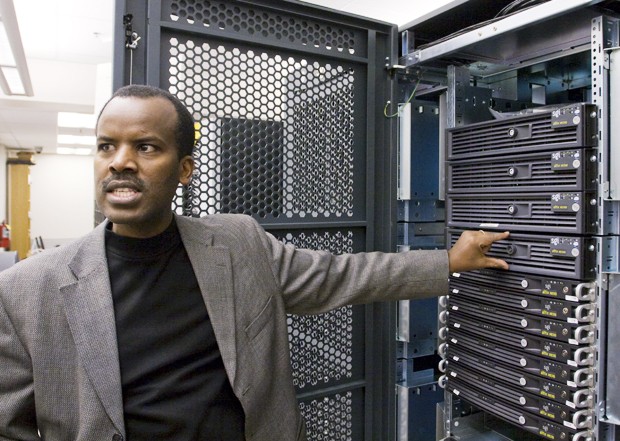Deep in the underbelly of the University of MinnesotaâÄôs Walter Library, Dr. Birali Runesha is at home among the long rows of humming computers and blinking lights. The Minnesota Supercomputing Institute, where Runesha serves as director of scientific computing and applications, is also home to one of the UniversityâÄôs newest assets âÄî more than 8,000 cores of additional computing power, codenamed âÄúItasca,âÄù set to open to researchers soon. âÄúHaving a system like [Itasca] available to the researchers gives us an edge to the competition,âÄù Runesha said. ItascaâÄôs computing power was ranked 67th of 500 on a recently published list of the worldâÄôs top supercomputers. The machine is owned by the University; most U.S. supercomputers are federally funded. âÄúOur resources are in the top three,âÄù Runesha said. âÄúWe might be No. 1.âÄù With more than 400 principal investigators and 4,000 users, Runesha said having Itasca in addition to Calhoun, the older system, will be crucial to many researchers at the University. With many University researchers anxiously waiting for ItascaâÄôs computing power, the pressing question seems to be when it will open. âÄúWell, weâÄôre pushing for it to be soon,âÄù Runesha said with a hesitant laugh. âÄúI guess thatâÄôs the best answer.âÄù One of these researchers is Dr. Graham Candler, whose area of expertise includes the study of âÄúhypersonic aerodynamic problems related to re-entry.âÄù âÄúI predict how a space shuttle flies when it gets back in the atmosphere,âÄù he explained. âÄúIt basically involves solving huge, nonlinear systems of equations.âÄù Currently, he is working on a project for NASA involving a new Mars rover. According to Candler, the rover is the largest ever sent to Mars and is âÄúabout the size of a Mini Cooper.âÄù The large size poses many problems for re-entry. By mapping a grid of data points around an object similar to a parachute and putting it under conditions like those experienced at re-entry, he is able to understand the physics of what is happening at each data point. With more computing power, Candler said he can increase the number of data points and understand more of the physics. âÄúWhen we have Itasca, itâÄôs going to completely open what we can do,âÄù he said. Candler explained that this will allow researchers to do more work and will bring in more projects from outside agencies like NASA. Theoretical astrophysicist Tom Jones uses MSI to simulate complex processes occurring in the universe, like the formation of large structures and the physics around black holes. Jones said he is currently waiting for Itasca to become available so he can study the dynamics of the generation of magnetism in the universe. âÄúIt will be the largest calculation of its kind thatâÄôs ever been done,âÄù he said. According to Jones, magnetism plays a subtle but crucial role in many processes throughout the universe. Using Itasca, Jones is going to set up a simulation that helps him and his colleagues explore that question. âÄúWeâÄôre very fortunate at the University to have resources to do that sort of thing,âÄù he said.

Image by Ian Larson
Minnesota Supercomputing Institute
‘Itasca’ to boost U computer power
The University’s new supercomputer will open the door for groundbreaking research.
Published December 8, 2009
0

